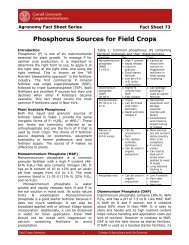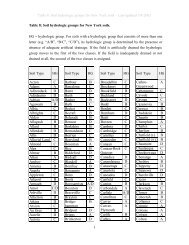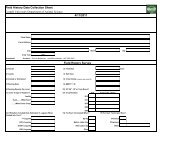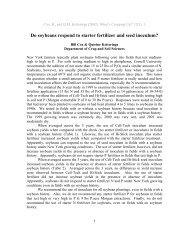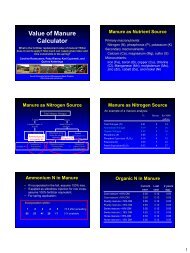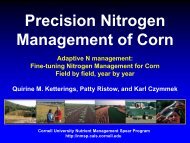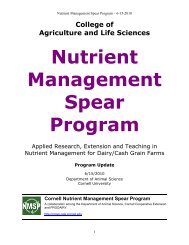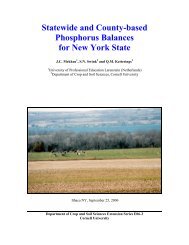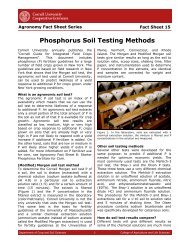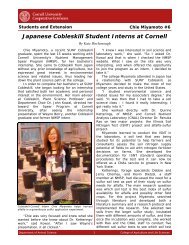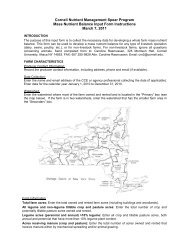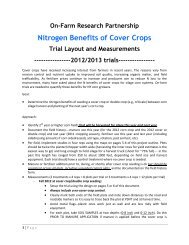Timing is Right for Manure Incorporation Study at Mapleview Dairy ...
Timing is Right for Manure Incorporation Study at Mapleview Dairy ...
Timing is Right for Manure Incorporation Study at Mapleview Dairy ...
Create successful ePaper yourself
Turn your PDF publications into a flip-book with our unique Google optimized e-Paper software.
manure. Shallow incorpor<strong>at</strong>ion using aer<strong>at</strong>orshas the potential to reduce nitrogen losses andretain more surface residue without the need<strong>for</strong> aggressive soil tillage.” Ketterings adds,“Our research st<strong>at</strong>ion trial showed gre<strong>at</strong>prom<strong>is</strong>e <strong>for</strong> aer<strong>at</strong>ors as manure incorpor<strong>at</strong>iontools but we needed to test th<strong>is</strong> on commercialfarms with a diversity of growing conditionsand soil types. Our project with Dave and nineother New York farms sprang from th<strong>is</strong> need.”2008 Season ResultsIn the 2008 growing season, there were nosignificant differences in corn silage yield, norin silage quality indic<strong>at</strong>ors like mo<strong>is</strong>turecontent, NDF (neutral detergent fiber), protein,starch, lignin, and estim<strong>at</strong>ed milk production,between the aer<strong>at</strong>or and ch<strong>is</strong>el plowtre<strong>at</strong>ments or the surface applic<strong>at</strong>ion withoutincorpor<strong>at</strong>ion <strong>at</strong> <strong>Mapleview</strong>. “The average yieldacross all tre<strong>at</strong>ments was 20.6 tons/acre <strong>at</strong>35% dry m<strong>at</strong>ter,” Place reports.The soil and plant nitrogen tests th<strong>at</strong> weredone as part of the study explained why noyield differences were seen between theincorpor<strong>at</strong>ion tre<strong>at</strong>ments and the surfaceapplic<strong>at</strong>ion. “The Illino<strong>is</strong> Soil Nitrogen Test(ISNT), the Pre-Sidedress Nitr<strong>at</strong>e Test (PSNT),and the L<strong>at</strong>e Season Corn Stalk Nitr<strong>at</strong>e Test(CSNT) all indic<strong>at</strong>ed there was already enoughN from soil organic m<strong>at</strong>ter <strong>for</strong> the crop. Noadditional N was needed <strong>for</strong> th<strong>is</strong> field. As aresult, even though the surface applic<strong>at</strong>ion ofmanure without incorpor<strong>at</strong>ion causes nitrogenvol<strong>at</strong>iliz<strong>at</strong>ion losses, we saw no yielddifferences between the manure applic<strong>at</strong>iontre<strong>at</strong>ments,” Ketterings explains. “We did seehigher yields with both aer<strong>at</strong>or and ch<strong>is</strong>elincorpor<strong>at</strong>ion <strong>at</strong> farm-trials where the loss of Nfrom the surface applic<strong>at</strong>ion resulted in anitrogen deficiency. And, in those trials, theaer<strong>at</strong>or did as good a job as the ch<strong>is</strong>el plowwith conserv<strong>at</strong>ion of the nitrogen from themanure.”While comparing the two incorpor<strong>at</strong>ion tools<strong>at</strong> h<strong>is</strong> farm, F<strong>is</strong>her noticed there was less fueland horsepower required to pull the Aerway ®versus the ch<strong>is</strong>el plow. F<strong>is</strong>her says, “Over thech<strong>is</strong>el, we’re saving probably a couple gallons[of fuel] per acre. After trying out the Aerway ®<strong>for</strong> the first time last year, 60% of manureapplied th<strong>is</strong> year was incorpor<strong>at</strong>ed with theAerway ® . “Yields are <strong>at</strong> least as good as lastyear,” F<strong>is</strong>her added.Benefits of On-Farm ResearchAs an extension educ<strong>at</strong>or, Barney was a keyplayer in making research findings accessibleto farmers and ensuring research relevancy.He emphasizes the importance of the teambased,on-farm, research approach used bythe NMSP. “Good working rel<strong>at</strong>ionshipsbetween the university, extension and farmingcommunities are essential. Th<strong>is</strong> ensuressuccess <strong>for</strong> all parties involved, including thepriv<strong>at</strong>e sector.” As Barney continued, “Thesetypes of projects are multipliers. People willlearn from their experiences with the research,and will pass th<strong>at</strong> on to anyone they interactwith.”For F<strong>is</strong>her, involvement with research <strong>is</strong>nothing new. As Barney, whose family hasbeen working with F<strong>is</strong>her <strong>for</strong> over 45 years,comments of F<strong>is</strong>her, “I have respect <strong>for</strong> wh<strong>at</strong>he does with the farm. He’s very innov<strong>at</strong>iveand <strong>is</strong> always willing to look through researchand see where it fits h<strong>is</strong> oper<strong>at</strong>ion.”“Th<strong>is</strong> study brings up questions <strong>for</strong> me aboutwh<strong>at</strong> <strong>is</strong> happening on the other farms in thetrial.” Says F<strong>is</strong>her, “I like to learn how to dothings better and cheaper. I’ve always doneprojects with Cornell Cooper<strong>at</strong>ive Extension,whether with cows or crops. I learn from thepeople who come out to the farm, and ouremployees learn too.”(October 23, 2009)The Nutrient Management Spear Program (NMSP) <strong>is</strong> an applied research, teaching and extension program <strong>for</strong> fieldcrop fertilizer and manure management on dairy and livestock farms. It <strong>is</strong> a collabor<strong>at</strong>ion among faculty, staff andstudents in the Department of Animal Science, Cornell Cooper<strong>at</strong>ive Extension, and PRO-DAIRY. Our v<strong>is</strong>ion <strong>is</strong> to assesscurrent knowledge, identify research and educ<strong>at</strong>ional needs, facilit<strong>at</strong>e new research, technology and knowledge transfer,and aid in the on-farm implement<strong>at</strong>ion of str<strong>at</strong>egies <strong>for</strong> field crop nutrient management including timely applic<strong>at</strong>ion o<strong>for</strong>ganic and inorganic nutrient sources to improve farm profitability while protecting the environment. An integr<strong>at</strong>ednetwork approach <strong>is</strong> used to address research, extension and teaching priorities in nutrient management in New YorkSt<strong>at</strong>e. For more in<strong>for</strong>m<strong>at</strong>ion on NMSP projects and extension/teaching activities, v<strong>is</strong>it the program website(http://nmsp.css.cornell.edu) or contact Quirine Ketterings <strong>at</strong> qmk2@cornell.edu or (607) 255-3061.Department of Animal Science 2 College of Agriculture and Life Sciences



